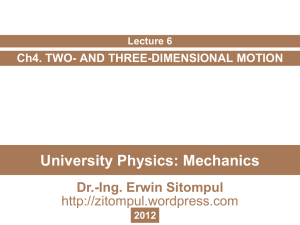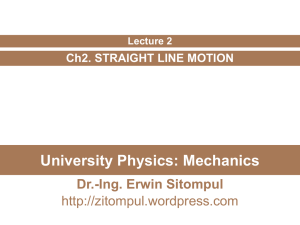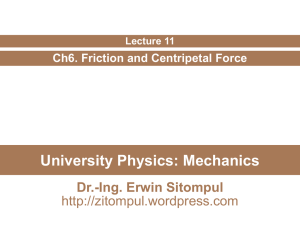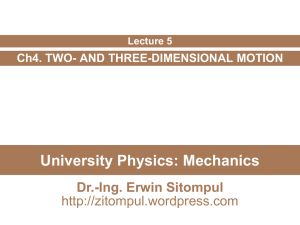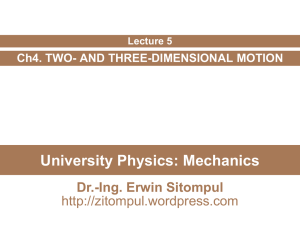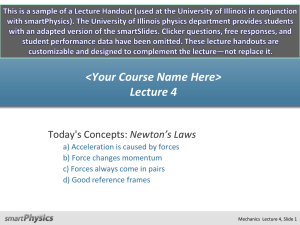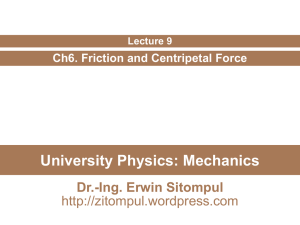University Physics - Erwin Sitompul
advertisement
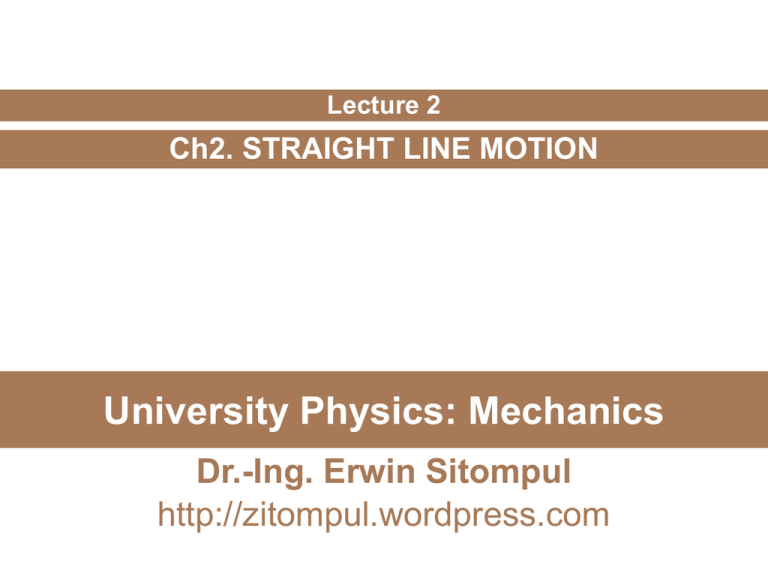
Lecture 2 Ch2. STRAIGHT LINE MOTION University Physics: Mechanics Dr.-Ing. Erwin Sitompul http://zitompul.wordpress.com Solution for Homework 1: Truck You drives a truck along a straight road for 8.4 km at 70 km/h, at which point the truck runs out of gasoline and stops. Over the next 30 min, you walk another 2.0 km farther along the road to a gasoline station. (a) What is your overall displacement from the beginning of your drive to your arrival at the station? x1 0 x2 8.4 2.0 10.4 km x x2 x1 10.4 km 0 10.4 km (b) What is the time interval Δt from the beginning of your drive to your arrival at the station? 8.4 km tdrv 0.12 h t tdrv twlk 70 km/h 0.12 h 0.5 h 0.62 h twlk 30 min 0.5 h Erwin Sitompul University Physics: Mechanics 2/2 Solution for Homework 1: Truck (c) What is your average velocity vavg from the beginning of your drive to your arrival at the station? Find it both numerically and graphically. vavg Erwin Sitompul x 10.4 km t 0.62 h 16.77 km/h University Physics: Mechanics 2/3 Solution for Homework 1: Truck (d) Suppose that to pump the gasoline, pay for it, and walk back to the truck takes you another 45 min. What is your average speed from the beginning of your drive to you return to the truck with the gas? total distance 8.4 2 2 12.4 km total time interval 0.12 0.5 0.75 1.37 hr savg total distance Erwin Sitompul t 12.4 km 1.37 hr 9.05 km/h University Physics: Mechanics 2/4 Instantaneous Velocity and Speed Instantaneous velocity (or simply velocity) is the average velocity over a very short period of time interval x dx v lim t 0 t dt Velocity v at any instant is the slope of the position-time curve. Instantaneous speed (or simply speed) is the magnitude of velocity, that is, speed is velocity without any indication of direction dx speed dt Erwin Sitompul University Physics: Mechanics 2/5 Motion with Constant Velocity dx v dt constant dx v dt dx v dt x vt c Motion with constant velocity on x-t graph Erwin Sitompul Taking at time t0 = 0 the position is at x0 c = x0 x x0 vt University Physics: Mechanics 2/6 Acceleration Average acceleration is the ratio of change in velocity to the time interval. aavg v2 v1 t2 t1 v t Instantaneous acceleration (or simply acceleration) is the derivative of the velocity with respect to time. v dv a lim t 0 t dt Erwin Sitompul dv d dx d 2 x 2 a dt dt dt dt University Physics: Mechanics 2/7 Motion with Constant Acceleration dv dt dv a dt a constant dv a dt v at c Taking at time t0 = 0 the velocity equals v0 c = v0 Motions with constant acceleration on v-t graph Erwin Sitompul v v0 at University Physics: Mechanics 2/8 Motion with Constant Acceleration v v0 at dx v dt dx (v0 at ) dt dx (v 0 at ) dt 1 x v0t at 2 c 2 Motions with constant acceleration on v-t graph Taking at time t0 = 0 the position is at x0 c = x0 1 2 x x0 v0t at 2 Erwin Sitompul University Physics: Mechanics 2/9 Motion with Constant Acceleration 1 2 x x0 v0t at 2 From these two equations, the following equations can be derived: v v0 at v2 v02 2a( x x0 ) 1 x x0 (v0 v)t 2 1 2 x x0 vt at 2 a constant Erwin Sitompul University Physics: Mechanics 2/10 Questions What is velocity in intervals A, B, C, D 1 m/s 0 m/s What is acceleration in intervals A, B, C –1.5 m/s 2 m/s2 0 m/s2 –0.5 m/s2 2 m/s Erwin Sitompul University Physics: Mechanics 2/11 Example: Porsche Spotting a police car, you brake a Porsche from a speed of 100 km/h to a speed of 80.0 km/h during a displacement of 88.0 m, at a constant acceleration. (a) What is that acceleration? v2 v02 2a( x x0 ) 22.222 27.782 2a(88 0) 22.222 27.782 a 1.58 m/s2 2 88 1000 m 3600 s 27.78 m/s 100 km/h 100 1000 m 80 km/h 80 3600 s 22.22 m/s v v0 at v 2 v02 2a ( x x0 ) x x0 v0t 12 at 2 x x0 12 (v0 v )t x x0 vt 12 at 2 Erwin Sitompul University Physics: Mechanics 2/12 Example: Porsche Spotting a police car, you brake a Porsche from a speed of 100 km/h to a speed of 80.0 km/h during a displacement of 88.0 m, at a constant acceleration. (b) How much time is required for the given decrease in speed? v v0 at v v0 22.22 27.78 t 3.52 s a 1.58 v v0 at v 2 v02 2a ( x x0 ) x x0 v0t 12 at 2 x x0 12 (v0 v )t x x0 vt 12 at 2 Erwin Sitompul University Physics: Mechanics 2/13 Example: Porsche Car accelerating and decelerating Erwin Sitompul University Physics: Mechanics 2/14 Questions Which time periods indicates that an object moves at constant speed? What are (a) Initial direction of travel? – (b) Final direction of travel? + (c) Does the particle stop momentarily? Yes (d) Is the acceleration positive or negative? + (e) Is the acceleration constant or varying? Constant E, where a = 0 Erwin Sitompul University Physics: Mechanics 2/15 Questions How far does the runner travel in 16 s? x x0 12 (v0 v)t x (v0 v)t 1 2 x4 12 (4 4)4 16 x2 12 (8 8) 8 64 x1 12 (0 8) 2 8 Erwin Sitompul x3 12 (8 4)2 12 xtotal x1 x2 x3 x4 University Physics: Mechanics 2/16 Example: Race A caravan moves with a constant velocity of 60 km/h along a straight road when it passes a roadster which is at rest. Exactly when the caravan passes the roadster, the roadster starts to move with an acceleration of 4 m/s2. x0 0, t0 0 vcaravan 60km h 16.67 m s (a) How much time does the roadster need to catch up the caravan? xcaravan xroadster x0,caravan vcaravan t x0,roadster v0,roadster t 12 aroadstert 2 0 16.67t 0 0t 12 4t 2 2t 2 16.67t 0 t (t 8.33) 0 t1 0, t2 8.33 s Thus, the roadster will catch up the caravan after 8.33 s. Erwin Sitompul x x0 vt v v0 at x x0 v0t 12 at 2 v 2 v02 2a ( x x0 ) x x0 12 (v0 v )t x x0 vt 12 at 2 University Physics: Mechanics 2/17 Example: Race A caravan moves with a constant velocity of 60 km/h along a straight road when it passes a roadster which is at rest. Exactly when the caravan passes the roadster, the roadster starts to move with an acceleration of 4 m/s2. x0 0 Distance traveled (b) How far does the roadster already move when it catches up the caravan? xroadster x0,roadster v0,roadstert 12 aroadstert 2 0 (0)(8.33) 12 (4)(8.33)2 xcaravan x x0 vt v v0 at 138.9 m x0,caravan vcaravant 0 (16.67)(8.33) 138.9 m x x0 v0t 12 at 2 v 2 v02 2a ( x x0 ) Both the vehicles travel 138.9 m before they pass each other again. Erwin Sitompul x x0 12 (v0 v )t x x0 vt 12 at 2 University Physics: Mechanics 2/18 Example: Particle’s Movement The position of a particle is given by x = 4t2 – 2t + 10, where x is the distance from origin in meters and t the time in seconds. (a) Find the displacement of the particle for the time interval from t = 1 s to t = 2 s. x1 4(1)2 2(1) 10 12 x2 4(2)2 2(2) 10 22 x x2 x1 22 12 10 m (b) Find also the. average velocity for the above given time interval. x2 x1 22 12 10 m s vavg 2 1 t2 t1 (c) Find the instantaneous velocity of the particle at t = 0.5 s. dx v 8t 2 dt At t = 0.5 s, v 8(0.5) 2 2 m s Erwin Sitompul University Physics: Mechanics 2/19 Homework 2: Aprilia vs. Kawasaki An Aprilia and a Kawasaki are separated by 200 m when they start to move towards each other at t = 0. 200 m The Aprilia moves with initial velocity 5 m/s and acceleration 4 m/s2. The Kawasaki runs with initial velocity 10 m/s and acceleration 6 m/s2. (a) Determine the point where the two motorcycles meet each other. (b) Determine the velocity of Aprilia and Kawasaki by the time they meet each other. Erwin Sitompul University Physics: Mechanics 2/20 Homework 2 New You come late to a running exercise and your friends already run 200 m with constant speed of 4 m/s. The athletic trainer orders you to catch up your friends within 1 minute. (a) Determine the minimum speed you have to take so that you can fulfill the trainer’s order. (b) If you run with minimum speed, determine the point where you catch up your friends. Erwin Sitompul University Physics: Mechanics 2/21
